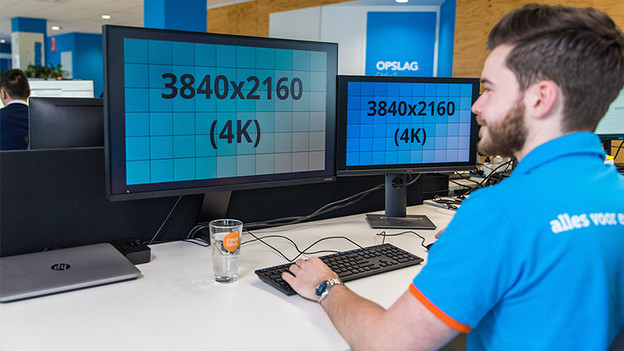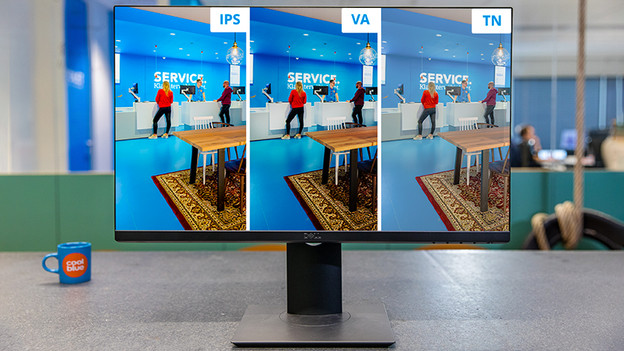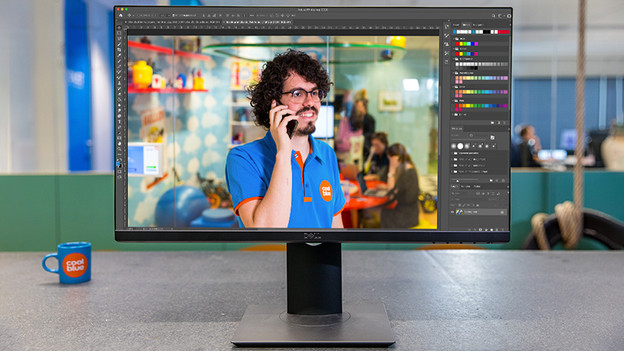
Written by Steven
Edited on
20 September 2022
·
14:12
How do you choose a monitor with a good color representation?
You're looking for a monitor with a good color representation. It can be hard to find, since there isn't just one specification for this. If you want nice colors, it's best to choose an HDR monitor with 10-bit color depth and an IPS panel. Do you use the monitor for graphic design? Choose a monitor that supports the Adobe RGB or DCI-P3 color space.

Choose a monitor
You want a monitor with nice colors, but don't know what to check. If you use the monitor to edit photos and videos, to play games, or to watch movies, make sure to check the following specifications for a good color representation.
- The panel type
- HDR type
- The brightness
- The color depth
- The color space and coverage
- Contrast and local dimming
- Required hardware

Panel type (IPS, VA, TN)
Do you want a monitor with a good color representation? Start with the panel. Many specifications are determined by the panel type. Often, the IPS monitor offers the most colors and widest viewing angle. Thanks to this, colors don't change when you move around. The contrast is better with VA than IPS, which causes black to be more black, and white to be more white. So, if you want nice colors, choose IPS. VA is the more affordable, but less good alternative. TN is discouraged.

HDR
HDR stands for High Dynamic Range. It's not a specification, but a default. It tells you if the monitor is set to the right brightness, contrast ratio, and color depth for an optimal color representation. This makes it easier to choose a colorful monitor. There are different types of HDR and DisplayHDR.
- Display HDR 400. A minimum of 400cd/m2 brightness, 8-bit color depth, 100% sRGB, and global dimming.
- Display HDR 600. A minimum of 600cd/m2 brightness, 10-bit color depth, >90% DCI-P3, and local dimming.
- Display HDR 1000. A minimum of 1000cd/m2 brightness, 10-bit color depth, >90% DCI-P3, and local dimming.
- HDR10. This is an open HDR default for monitors and content. The only requirement is a 10-bit color representation.
- The terms above are explained in the paragraphs below.

Brightness
HDR is mostly based on the brightness of your monitor. This brightness can enhance or weaken colors, and is expressed in candela per squared meter (cd/m2). A monitor with a high brightness shows the image that you are editing, just as bright as in real life. A high brightness contributes to a lively representation of characters and landscapes in games. Thanks to the high brightness, colors won't fade with incoming light.

Color depth (8-bit or 10-bit)
The color depth of your monitor determines how much gradient, so the number of different colors, your monitor shows. For example, an 8-bit monitor can show 16.8 million different colors. A 10-bit monitor can show 1.07 billion colors, which is 60 times more. This improves the fading of the colors, which makes it more gradient. It's most important for photo and video editing, but also to see nice color gradients while gaming.

Color space and coverage
Color depth describes the number of gradients between white and green. The color space describes how green the most green is. The extreme colors of the Adobe RGB color space are more lively and more realistic than the smaller sRGB color space. The sRGB is good enough for general use. But it's better to choose a monitor that supports Adobe RGB, also called aRGB, if you want to use it for photo editing. You choose DCI-P3 for video editing. The percentage indicates the number of colors of the profile that the monitor covers. For example 100% of sRGB.

Contrast and local dimming
The contrast shows the difference between the lightest and darkest color. When a monitor has a contrast ratio of 1000:1, the lightest pixel is 1000 times lighter than the darkest one. This is similar to the way a night sky looks, when the stars are very bright and the sky is very dark. This looks even better with deeper black levels. Local dimming adds a little extra, by lighting up the lighter parts of the screen but not the darker parts. This way, your colors very lively and the shadows very realistic.

Required hardware
You can now choose a monitor that shows lively and natural colors, but what hardware do you need for an optimal color representation? You need the following for HDR use:
- At least Windows 10 - Fall Creators Update
- A powerful video card (especially for 10-bit HDR gaming or editing)
- DisplayPort cable (for 4K HDR)
Article by Steven
Monitor Expert.
